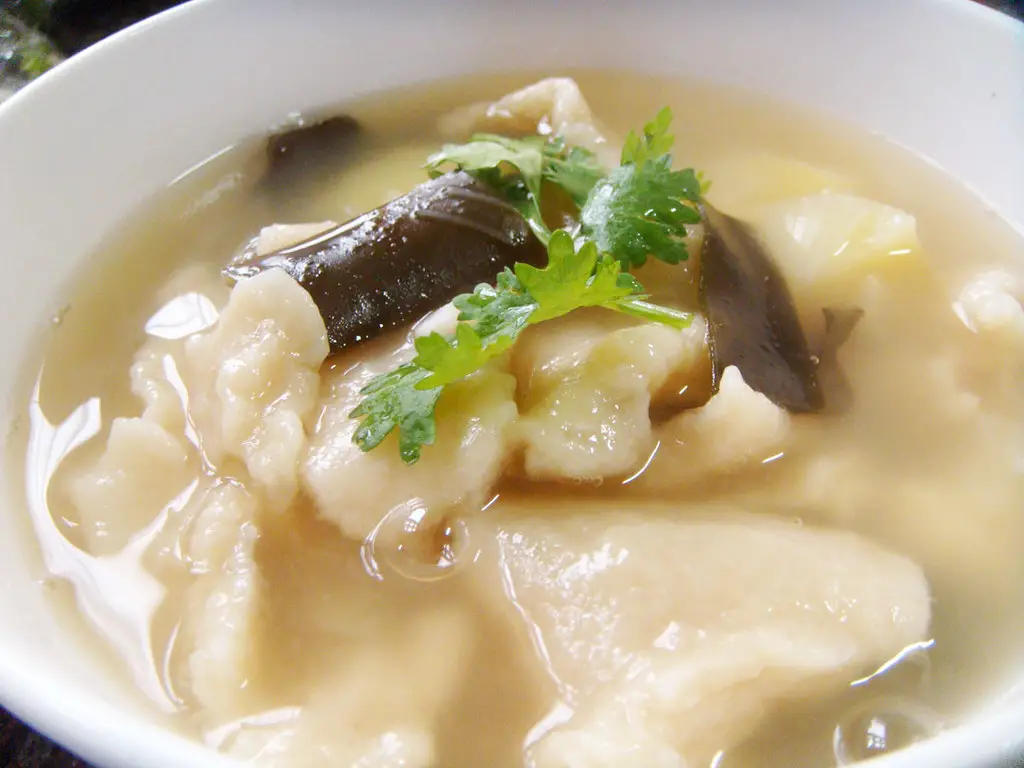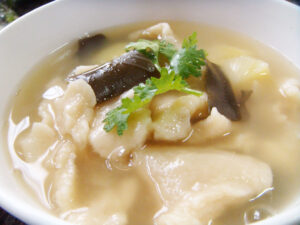Sujebi is a traditional Korean dish known for its hearty texture and warm, comforting flavors. It’s a type of soup featuring hand-torn pieces of dough, cooked in a rich broth with various vegetables and sometimes meat or seafood. This dish is popular for its simplicity and flexibility, allowing home cooks to adjust the ingredients according to their preferences. Here’s a detailed guide on how to make sujebi at home.
Ingredients
To make sujebi, you’ll need the following ingredients:
For the Dough:
2 cups of all-purpose flour
½ cup of water (add more if needed)
1 tablespoon of vegetable oil
½ teaspoon of salt
For the Broth:
6 cups of water
1 piece of dried kelp (kombu), about 4×4 inches
5-6 dried anchovies (heads and intestines removed)
1 onion, quartered
2 cloves of garlic, crushed
Additional Ingredients:
1 medium potato, diced
1 small zucchini, sliced
1 carrot, sliced
½ onion, sliced
2 green onions, chopped
Soy sauce, to taste
Salt, to taste
Optional: diced chicken, beef, or seafood for added protein
Instructions
Here’s how to make sujebi:
Step 1: Make the Dough
In a mixing bowl, combine the flour, salt, and vegetable oil.
Gradually add water while mixing with your hand or a spatula. Knead the dough until it’s smooth and elastic, about 10 minutes. If the dough is too dry, add more water, one tablespoon at a time.
Cover the dough with plastic wrap or a damp cloth and let it rest for at least 30 minutes.
Step 2: Prepare the Broth
In a large pot, add the water, dried kelp, dried anchovies, onion, and garlic. Bring to a boil over medium heat.
Reduce heat to low and simmer for about 15-20 minutes to extract flavors from the kelp and anchovies.
Remove the kelp and anchovies from the pot. You now have a flavorful broth base for your sujebi.
Step 3: Add Vegetables and Optional Protein
To the broth, add the diced potato, sliced zucchini, carrot, and onion. If you’re adding protein like chicken, beef, or seafood, add it now.
Continue to cook over medium heat for 10-15 minutes, or until the vegetables are tender and the meat is cooked through.
Step 4: Add the Sujebi Dough
Tear off small pieces of dough, flatten them slightly with your fingers, and drop them into the simmering broth. The pieces should be irregular in shape and size for a rustic look.
Stir occasionally to prevent the dough pieces from sticking to each other. Cook for about 5-10 minutes, or until the dough is cooked through and floats to the surface.
Step 5: Season and Serve
Add soy sauce and salt to taste, adjusting the seasoning to your preference.
Stir in the chopped green onions and let them cook for another minute or two.
Serve hot in bowls, and enjoy your homemade sujebi!
Tips and Variations
Spicy Version: Add some gochujang (Korean chili paste) or gochugaru (Korean chili flakes) to the broth for a spicy kick.
Seafood Sujebi: Use seafood broth or add shrimp, clams, or mussels for a seafood twist.
Vegetarian Sujebi: Skip the anchovies and use vegetable broth instead.
Sujebi is a dish that brings warmth and comfort, perfect for a chilly day or when you need a comforting meal. With its simple ingredients and flexible recipe, it’s a great addition to your cooking repertoire. Give it a try and enjoy the hearty, flavorful goodness of sujebi!
Additional Tips for Making Sujebi
Dough Consistency: When making the dough, ensure it’s not too sticky or too dry. It should be pliable and easy to tear without crumbling.
Resting Time: Letting the dough rest for at least 30 minutes helps improve its elasticity, making it easier to stretch and tear into smaller pieces.
Mixing Techniques: When adding the dough to the broth, use various shapes and sizes to create a more visually appealing and textured dish. You can also roll out the dough and cut it into small pieces for a more uniform appearance.
Serving Suggestions
Garnishes: Serve sujebi with additional garnishes like sliced red chili peppers, fresh cilantro, or sesame seeds for extra flavor and presentation.
Accompaniments: Sujebi pairs well with banchan (Korean side dishes) such as kimchi, pickled vegetables, or sautéed mushrooms.
Drinks: Consider serving with Korean drinks like soju or makgeolli (rice wine) for a more traditional experience.
Storing and Reheating
Storing Leftovers: If you have leftovers, store them in an airtight container in the refrigerator for up to 2-3 days. Keep the dough and broth separate for best results.
Reheating: Reheat the broth and add the dough pieces when ready to serve. This will prevent the dough from becoming too soggy. If you prefer a thicker consistency, reheat everything together, as the dough can help thicken the broth.
Sujebi Variations to Try
Mushroom Sujebi: Add a variety of mushrooms like shiitake or enoki to the broth for a rich umami flavor.
Herb-Infused Sujebi: Incorporate herbs like thyme or rosemary for an aromatic twist.
Spicy Meat Sujebi: For meat lovers, add sliced beef or pork with spicy gochujang for a hearty, spicy variant.
With these additional tips and variations, your sujebi experience can be customized to suit your taste preferences. The flexibility of the dish makes it easy to adapt and create your unique version. Whether you enjoy the traditional approach or experiment with new flavors, sujebi is sure to be a comforting and satisfying meal.




